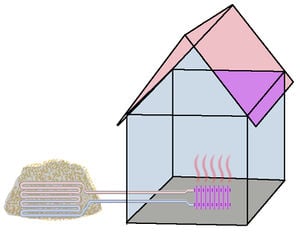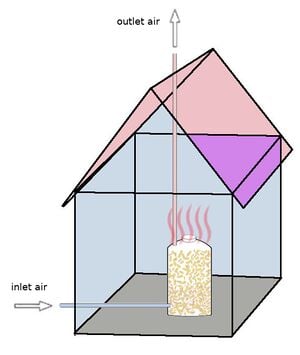m (link to other article added) |
(Fully grown article. Enjoy reading.) |
||
| Line 1: | Line 1: | ||
The '''compost heater''' | [[File:BioMeilerConcept.jpg|thumb|Using the heat of an external compost heap for warming up the inside of a house]] | ||
[[File:CompostHeaterSiloConcept.jpg|thumb|Using the heat of a compost heater silo for warming up the inside of a house]] | |||
The '''compost heater''' (also '''Biomeiler''') it a setup for utilization of the [[heat]] dissipation of a [[composting]] process. The thermal effect is well known from a compost heap, where the [[biomass]] is decayed by the digestion and metabolism of many different [[microbes]] and invertebrates. The heat is used, for instance, for a dwelling house. In contrast to the production of [[biogas]], the composting process requires enough [[oxygen]], resulting in an aerobic decay. | |||
The french agronomist [[Jean Pain]] is held responsible for the invention of the Biomeiler. His system was a combination of a sealed biogas reactor in the center of a big compost heap, producing both biogas and heat. He also worked on agricultural principles in harmony with nature. | |||
== | ==Compost Heap in the Garden with Water Circulation System== | ||
{{main|Biomeiler}} | {{main|Biomeiler}} | ||
The 'Biomeiler' has been invented by [[Jean Pain]]. It exploits the heat of a big compost heap in the [[garden]] to warm up a house. | The 'Biomeiler' has been invented by [[Jean Pain]]. It exploits the heat of a big compost heap in the [[garden]] to warm up a house. This type requires a big compost heap in the Garden, interveined with a spirally water hose. The water circulation conducts the heat to the building, where it can be fed to a heating circuit. | ||
The compost heap must contain at least 8000 liters biomass to be able of holding a temperature during the freezing winter, allowing the thermophilic microbes to continue their work | |||
==Compost Heater Silo== | ==Compost Heater Silo inside a Building== | ||
{{main|Compost heater silo}} | {{main|Compost heater silo}} | ||
The composting process is running in an airtight container inside a house. | The composting process is running in an airtight container inside a house. The produced heat can be distributed by a heating circuit, whereas a simple model of such a compost heater silo does not require a water circulation, radiating the heat directly to the interiors of the house. | ||
== Calculations == | |||
In a 1000 square meter garden a considerable amount of biomasse (chipped wood, foliage, chopped bush) can be harvested. This amount holds an annual energy of about 4000 kWh. The following data are from [[energy forestry]]. | |||
{| class="wikitable" | |||
|- class="hintergrundfarbe6" | |||
! Data Type || Values | |||
|- | |||
|bgcolor=#ececec| Harvest per hectare || 8 to 12 tons | |||
|- | |||
|bgcolor=#ececec| Energy contents of biomass || 3,86 kWh per kg wood (at 20% residual moisture) | |||
|} | |||
While the heating of older dwelling houses require more than 20,000 kWh per year, the recently developed well insulated houses require less than 10000 kWh. The latter can be easily served, for instance, by a compost heater silo of the size 2000 l, making the interior of the house comfortably warm throughout the year. | |||
== Further Information on the Internet == | |||
* [http://www.journeytoforever.org/biofuel_library/methane_pain.html Digital reproduction] of 1981 ''Readers Digest'' article | |||
* [http://www.comitejeanpain.be Comite Jean Pain], Belgian organisation established to promote the methods of Jean Pain | |||
* [http://www.springerlink.com/content/t164018548752605/fulltext.pdf European bioconversion projects and realizations for macroalgal biomass: Saint-Cast-Le-Guildo (France) experiment], reference to Pain method of breaking down wood chips in relation to the composting of macroalgal biomass | |||
* [http://www.permacultureactivist.net/PeterBane/Jean_Pain.html Another Kind of Energy or ComPost-Modernism], essay by Peter Bane for the ''Permaculture Activist'' | |||
* [http://www.motherearthnews.com/Renewable-Energy/1981-07-01/DIY-Water-Heating-Compost.aspx DIY Water Heating with Compost], article in ''Mother Earth News'' (July/August 1981) | |||
* [http://www.builditsolar.com/Projects/BioFuel/biofuels.htm#CompostHeat A collection of articles innovating on the method], ''Build It Solar'' (magazine) | |||
[[Category:Composting| ]] | [[Category:Composting| ]] | ||
Revision as of 11:40, 18 October 2018


The compost heater (also Biomeiler) it a setup for utilization of the heat dissipation of a composting process. The thermal effect is well known from a compost heap, where the biomass is decayed by the digestion and metabolism of many different microbes and invertebrates. The heat is used, for instance, for a dwelling house. In contrast to the production of biogas, the composting process requires enough oxygen, resulting in an aerobic decay.
The french agronomist Jean Pain is held responsible for the invention of the Biomeiler. His system was a combination of a sealed biogas reactor in the center of a big compost heap, producing both biogas and heat. He also worked on agricultural principles in harmony with nature.
Compost Heap in the Garden with Water Circulation System
The 'Biomeiler' has been invented by Jean Pain. It exploits the heat of a big compost heap in the garden to warm up a house. This type requires a big compost heap in the Garden, interveined with a spirally water hose. The water circulation conducts the heat to the building, where it can be fed to a heating circuit.
The compost heap must contain at least 8000 liters biomass to be able of holding a temperature during the freezing winter, allowing the thermophilic microbes to continue their work
Compost Heater Silo inside a Building
The composting process is running in an airtight container inside a house. The produced heat can be distributed by a heating circuit, whereas a simple model of such a compost heater silo does not require a water circulation, radiating the heat directly to the interiors of the house.
Calculations
In a 1000 square meter garden a considerable amount of biomasse (chipped wood, foliage, chopped bush) can be harvested. This amount holds an annual energy of about 4000 kWh. The following data are from energy forestry.
| Data Type | Values |
|---|---|
| Harvest per hectare | 8 to 12 tons |
| Energy contents of biomass | 3,86 kWh per kg wood (at 20% residual moisture) |
While the heating of older dwelling houses require more than 20,000 kWh per year, the recently developed well insulated houses require less than 10000 kWh. The latter can be easily served, for instance, by a compost heater silo of the size 2000 l, making the interior of the house comfortably warm throughout the year.
Further Information on the Internet
- Digital reproduction of 1981 Readers Digest article
- Comite Jean Pain, Belgian organisation established to promote the methods of Jean Pain
- European bioconversion projects and realizations for macroalgal biomass: Saint-Cast-Le-Guildo (France) experiment, reference to Pain method of breaking down wood chips in relation to the composting of macroalgal biomass
- Another Kind of Energy or ComPost-Modernism, essay by Peter Bane for the Permaculture Activist
- DIY Water Heating with Compost, article in Mother Earth News (July/August 1981)
- A collection of articles innovating on the method, Build It Solar (magazine)